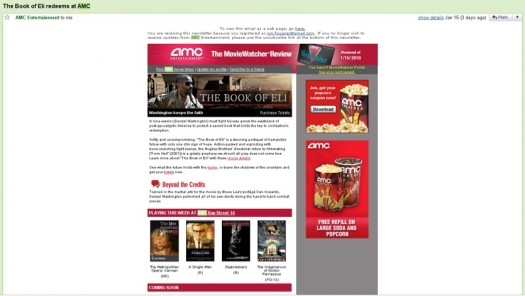This is Part 4 of Jon Fougner’s guest series on Cinema Profitablility – today he focuses on the marketing.
Marketing
The last time you went to a movie, how did you decide where to see it? If you’re like most Americans, you simply went to the nearest theater showing it. (Of course, if you’re reading this, you may be a cinephile and therefore a bit more discerning in your choice!) That’s even less brand loyalty than you might show in where you buy commodities like gasoline.
The cinemas have historically deferred to their vendors, typically owned by large media companies, to advertise their products. (Of course, the cinemas have done the crucial re-marketing work of on-site merchandising for the products, in the form of movie trailers, but I doubt that those trailers do much to engender loyalty to the particular cinema (chain) in which they’re shown.) That’s extraordinary; even in verticals where the manufacturers typically buy a lot of media, such as auto, CPG, and QSR, the retailer typically advertises as well, both to complete the bottom of the demand generation funnel and to take share from competing demand fulfillers.
It’s extraordinary, and it may have to change. The good news: many of the needed tactics don’t require paid media. A few are laid out below.
The Big 3 should build low-touch customer relationship management systems anchored by e-mail. A few of the places to capture e-mail addresses from:
• online sales,
• ticket kiosks,
• face-to-face ticket and food sales (when customer lines are not prohibitively long),
• social media,
• and even the studios, whose e-mail lists sometimes go wasted.
Around each e-mail address, build a CRM profile, including:
• first and last name,
• gender,
• home address,
• preferred genres,
• preferred screening times,
• preferred screening days,
• average purchase size,
• price sensitivity (e.g., coupon redemption behavior),
• and viewed trailer history (for data analysis once the advertised film comes out).
Send customers highly-customized e-mails, measuring success by value of tickets sold. (This measurement requires conversion data from the online POS, which should be a show-stopping negotiating demand in any agreement with a 3rd party broker.) Some of the blocking and tackling of optimizing these e-mails is obvious. For instance, the preview field in a major Webmail provider like Gmail shouldn’t tell people to unsubscribe:
And, for instance, no clickable film title (in the screen below, “A Single Man”)…

…should land on a page whose above-the-fold content makes no mention of it:

Some of the fruits hang higher, but tips from entertaining decks like DJ Waldow’s will help spot them. Most of the benefit, however, will come from relentless testing, likely through an e-mail marketing agency. The promotional engine of this CRM system should be a loyalty program. Unlike AMC and Regal, Cinemark doesn’t even appear to have a loyalty program in the U.S.:

The program should leverage game dynamics, such as points collection, leveling up, social status, rewards, and randomization. As CRM gold standard Harrah’s knows, variable positive reinforcement is key. AMC owner Apollo co-owns Harrah’s and could choose to share some of its CRM playbook. The rewards should be meaningful. At a 58% weighted-average gross margin with 90%+ wasted admissions inventory, it’s hard to understand why AMC spends less than 1% of revenues from loyalty customers on their rewards. (For 10 ticket purchases = $83, you get 1 small popcorn, with COGS less than $83 x 1% = $0.83.)
The company’s website will serve several purposes: loyalty program, e-ticketing, gift cards and more. Modeling the value of users’ interactions with these features is the first step towards prioritizing amongst them and optimizing for the highest value conversions while culling all else. Today, if a user visits the Big 3 sites, she’ll experience:
• an emphasis on products rather than her needs,
• clutter,
• irrelevant banner ads,
• text in all capital letters,
• unconventionally small text,
• unconventional hyperlink colors,
• inscrutable text color schemes,
• unconventional background colors,
• links whose landing pages have no apparent correspondence to the link text,
• unclear calls to action,
• search parameters pre-filled to show 0 results,
• altogether empty search results without helpful suggestions,
• overcomplicated registration flows,
• missing standard navigation to home (clickable logo in upper left),
• broken mouse-over ajax interfaces,
• unnecessarily narrowly constrained clickable areas,
• and e-mailed passwords (!).
Experts like SiteTuners.com offer consultation and testing in order to identify and remedy problems like these.
END OF PART Four Tomorrow: Marketing 2 and Margins
— Jon Fougner
Jon leads local product marketing and monetization at Facebook, working with the advertising engineers and product managers to build products for local businesses, ranging from restaurants to movie theaters.





